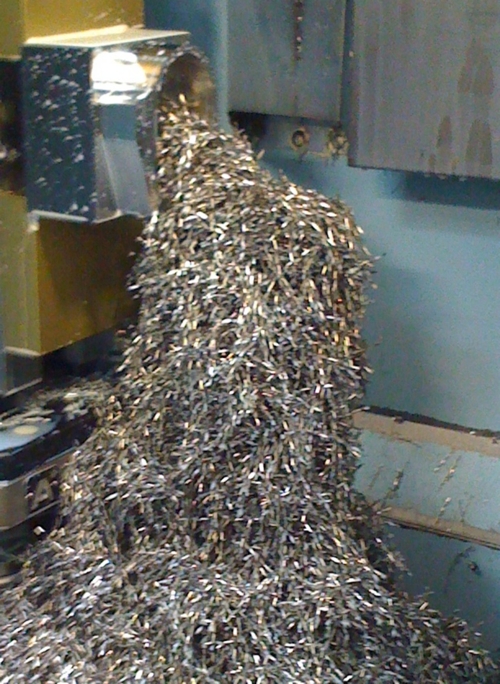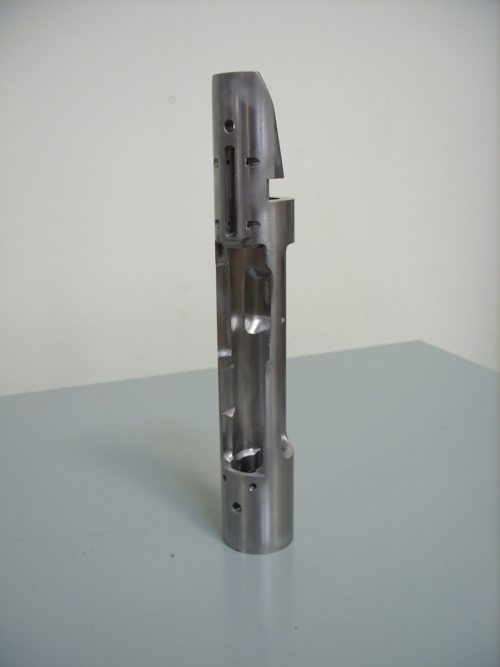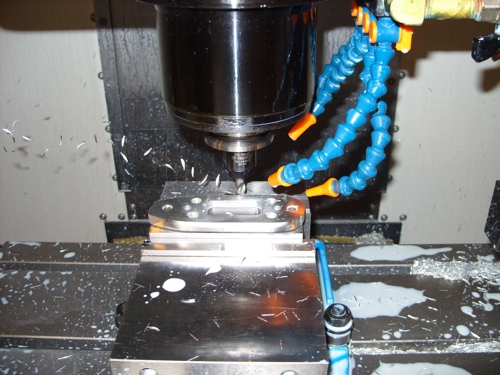Firearms Manufacturer Hits the Mark with New Toolpath Engine, Saving Thousands of Dollars in the First Few Months of Use
McMillan Machine Co.'s General Manager Affirmed One Order Paid for the Software -- "It's Been All Profit After That"
When a Navy Seal takes aim at a target through the scope of his TAC™-50 McMillan Tactical Rifle, he does so with confidence in his weapon-maker’s nearly 40 years of precision firearms manufacturing.

McMillan Primarily Machines Parts for Weapons Systems, Including Barrels, Firing Components, Housings, Chassis, Mounts, Adapters and Couplers.
Gale McMillan, founder of the three-entity McMillan family of companies, began producing firearm stocks in 1973 for his use in highly demanding and competitive bench-rest shooting matches. Fellow competitors, always in search of the next competitive edge, asked the inventor to produce some stocks for their rifles as well. From these roots, McMillan has grown into one of the most well-known and respected brands in the firearms industry.
In 1987, McMillan decided he could save time and money, and improve quality, by producing firearms hardware in house, rather than buying, dismantling, and rebuilding components from Remington. McMillan Machine Co. was born.
“It ballooned from there,” says Duncan Davis, general manager of McMillan Machine Co. “Then we started building the 50-calibers, which is the firearm for which McMillan is best known.”
Although McMillan Machine has produced aftermarket parts for Harley-Davidson and components for Cessna, the company primarily machines parts for weapons systems. Barrels, firing components, housings, chassis, mounts, adapters and couplers comprise the majority of McMillan Machine’s workload. It is one of the three companies in the McMillan Family, which includes McMillan Fiberglass Stocks, McMillan Machine Co., and McMillan Firearms Manufacturing.
The McMillan dedication to quality and continuous improvement that has made its products the weapons of choice for America’s elite troops led it to try a new advancement in manufacturing software, the ultra high-performance toolpath engine VoluMill.

A VoluMill Toolpath in the Process of Reducing a 28-Pound Block of 17-4 Stainless Steel Into a 2.8-pound Weapon-Mount Component.
VoluMill is a plug-in toolpath engine used in place of traditional roughing methods when ease of programming, reducing cycle times, extending tool life, and reducing the stress on machine tools is a priority. This easy-to-use software program, which is completely integrated into McMillan’s GibbsCAM® system, and can work with any CAM system, dynamically manages material removal rates to keep an even and user-controllable load on the cutting tool. Ideal machining conditions are established and maintained throughout the program for any combination of part geometry, material, machine and cutting tool. Machine tools are fed commands that enable them to operate at peak efficiency levels, enabling the use of machining parameters that both reduce cycle times and extend cutting-tool life.
Urged to try VoluMill for 30 days free of charge by his GibbsCAM reseller, John
Gulstad of Technical Manufacturing Information (TMI), Davis was eager. “I like to try the latest and greatest new stuff,” Davis says. “I’m always curious to see if I can do something better.”
According to Davis, VoluMill is something better. “We decided to get it after the first week,” Davis says. “It impressed us enough right off the bat that I didn’t even bother looking at other options. It did more than I expected it would do."
Davis put VoluMill to work on a 6Al4V titanium mount-component that required a lot of rough machining and was hard on tools. “The results were so dramatic that that one order paid for the software,” Davis says. “It’s been all profit after that.”

VoluMill Toolpaths Were Used to Machine This Receiver for McMillan’s Famous .50-Caliber BMG 50 Rifle.
Davis said the titanium part previously took 80 minutes to rough, at 1,225 RPM and 6.25 IPM, using a .315” axial depth of cut and a 0.220 radial depth of cut with GibbsCAM toolpaths. When VoluMill toolpaths were applied, the radial depth of cut was reduced to 0.035” using the same ½-inch diameter, 5-flute, solid-carbide end mill, but the axial depth of cut was increased to 1.180”, the spindle speed to 3,056 RPM, and the feed rate to 100 IPM. The use of the new parameters, which would not be remotely possible with traditional toolpaths, produced a nearly 10-fold increase in the material removal rate, reducing the roughing time to 30 minutes, a savings of 50 minutes per part. Tool life was also extended 10-fold, from four parts per tool previously to the current efficiency level of 40 parts per tool.
A new part, which required machining a 28-pound block of 17-4 stainless steel down to a 2.8-pound finished part took 2 hours. The bulk of the material removal took an hour and 15 minutes. Before using VoluMill, Davis says that, per their established practices, he would have used a series of 5 indexable tools, and estimates that the first tool alone would have taken 2 hours 20 minutes. “We ran a total of 40 pieces,” Davis reports. “We were able to save an estimated $4,800 in machining time and an additional $2,400 in tooling cost.”
McMillan Machine has utilized VoluMill toolpaths on several jobs that were already in the shop with the prices previously established. “We re-programmed some jobs that were not so profitable in the past,” Davis says. “I now can manufacture them more efficiently and get to a good margin.” Davis says that his programming team most recently re-programmed three different parts using VoluMill and the resulting savings added up to $8,400.

Chips Fly as a VoluMill Toolpath Goes to Work on a Component at McMillan Machine Co.
VoluMill’s positive impact on the bottom line extends far beyond mere cycle time improvements. It affects programming time, tool life, energy consumption, machine tool spindle life, coolant longevity, and labor. According to Davis, it even makes his job quotes more accurate, which saves on lost shop hours.
“It’s safe to say that we see a 5-10 percent savings in lost quotes,” Davis says. “I quote more accurately now. Since VoluMill is so quick and easy to use, I’ll generate a couple of simple geometries in GibbsCAM and run VoluMill on it just to look at the run time. So I’ve already got part of the job programmed before I even get it and it only takes 30 minutes to give me a ballpark of where I’m going to be on run time. If a customer gives me a model on which to base my quote, it’s even better.”
Davis estimates that, in the first four months using VoluMill, he saved $5,000 in programming time and 200 hours – or $16,000 – in cycle time. The increased tool life that VoluMill toolpaths provide has saved $3,000 in cutting-tool costs. Further, Davis says McMillan likely saves 65 percent on energy costs when running a VoluMill toolpath since the machine is running more efficiently and for less time to complete a job.
McMillan’s coolant bill also has decreased, by 20-25 percent. “We’re keeping things a lot cooler with the consistent tool load and by taking the shallower radial depths of cut, and the coolant isn’t breaking down as fast and is lasting a lot longer,” he says.
Jobs using VoluMill toolpaths are creating savings in man hours, which can then be deployed to other projects. Davis says McMillan saves between $900-$1,000 per week on labor costs when a VoluMill job is running. “The operators can get that many more jobs done due to VoluMill,” he says.

McMillan Re-Programmed Three Different Parts Using VoluMill and the Resulting Savings Added up to $8,400.
An obvious but as-yet difficult-to-quantify benefit is VoluMill’s impact on machine-tool wear. Davis says VoluMill toolpaths reach a maximum spindle load of 18 percent in titanium, compared to 70-80 percent using traditional toolpaths. “Common sense tells me that it’s saving wear and tear on our machines,” he says.
GibbsCAM reseller Gulstad is a firm believer in VoluMill. “In every VoluMill sale I’ve made, it’s paid for itself in the first job or two,” Gulstad says. “It’s probably the most dynamic and important CAM development in many years. Every one of my GibbsCAM customers who has tried VoluMill has bought VoluMill.”
Want more information? Click below.